Today I will be discussing what the golden ratio is (otherwise known as the golden mean) and how we can use it to improve your artwork.
- What Is the Golden Ratio?
- What Is the Golden Ratio?
- Calculations
- The Golden Rectangle
- The Fibonacci Sequence
- Golden Spiral
- Applying the Golden Ratio in Art
- Examples of the Golden Ratio
- Summary
- Want to Learn More?
- Thanks for Reading!
What Is the Golden Ratio?
The golden ratio is the ratio of approximately 1 to 1.618. These are extremely important numbers to mathematicians. But what do they mean to us artists?
Well there have been studies which suggest designs set out using the golden ratio are aesthetically pleasing. We can use the golden ratio to help design our paintings and position our subjects.
Who would have thought art and maths could have such a close connection? Luca Pacioli (a contemporary of Leonardo da Vinci) went as far as saying:
“Without mathematics there is no art.”
What Is the Golden Ratio?
The golden ratio has been around for some time and has influenced many areas of life, including architecture, maths, design and of course art.
Here is a rough timeline of the golden ratio’s history according to author Priya Hemenway:
- Phidias (490-430 BC) made the Parthenon statues that seem to embody the golden ratio.
- Euclid (c. 325-c. 265 BC), in his Elements, gave the first recorded definition of the golden ratio, which he called, as translated into English “extreme and mean ratio”.
- Fibonacci (1170-1250) mentioned the numerical series now named after him in his Liber Abaci. We will discuss the Fibonacci sequence later in this post.
- Luca Pacioli (1445-1517) defines the golden ratio as the “divine proportion” in his Divina Proportione.
- Charles Bonnet (1720-1793) points out that in the spiral phyllotaxis of plants going clockwise and counter-clockwise were frequently two successive Fibonacci series.
- Martin Ohm (1792-1872) is believed to be the first to use the term goldener Schnitt (golden section) to describe this ratio, in 1835.
- Édouard Lucas (1842-1891) gives the numerical sequence now known as the Fibonacci sequence its present name.
Calculations
I will try and keep this simple (as we do not need to understand all the complexities of the golden ratio as artists).
The golden ratio can be calculated as follows:

That weird symbol at the end represents the golden ratio.
I find this equation easier to understand in pictural format:
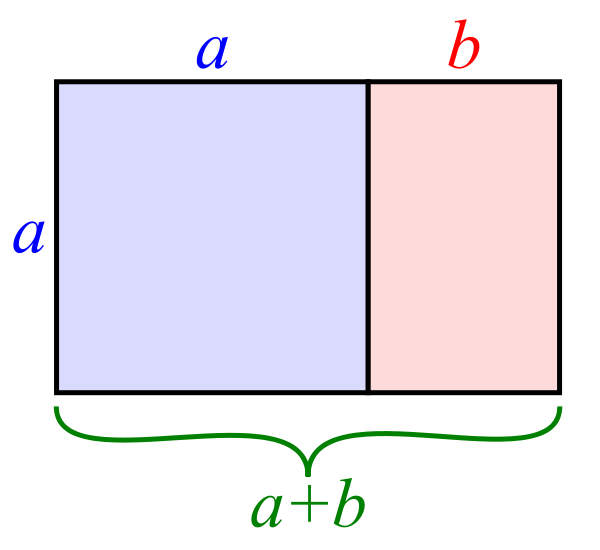
So a+b is to a as a is to b.
Confused yet? Keep reading as it becomes easier to understand when we apply it to certain situations.
The Golden Rectangle
Below is a golden rectangle, which means the side lengths are in golden ratio. If you take away that square on the left, another rectangle will remain which is also in golden ratio. This could continue indefinately.
There is some kind of peacefulness and beauty in infinite numbers, which is possibily why the golden ratio is so popular in design.

Creating the golden rectangle is easy using these steps. All you need is a compass.
Step 1 – Construct a simple square.
Step 2 – Draw a line down the middle of the square.

Step 3 – Grab your compass and place one point at the intersection at the bottom middle and draw down from the edge of top right corner, as shown below.

Step 4 – Complete the golden rectangle.
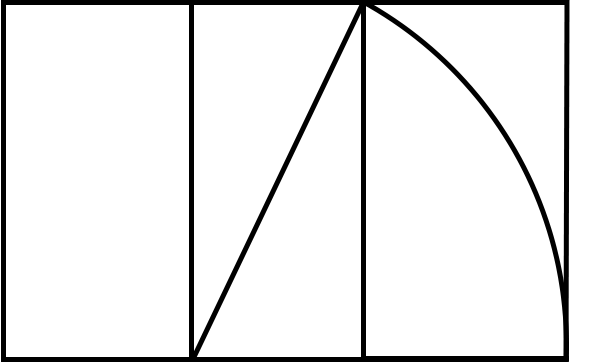
Note: This is for demonstration purposes only so it may not be the exact proportions of the golden ratio.
The Fibonacci Sequence
The following is the Fibonacci sequence: 0, 1, 1, 2, 3, 5, 8, 13, 21, 34, … The next number is found by adding up the two numbers before it.
When we take any two successive (one after the other) in the sequence, their ratio is very close to the golden ratio.
In fact, the later the numbers are in the sequence, the closer it becomes to the golden ratio.
This relationship between the Fibonacci sequence and the golden ratio is shown below:
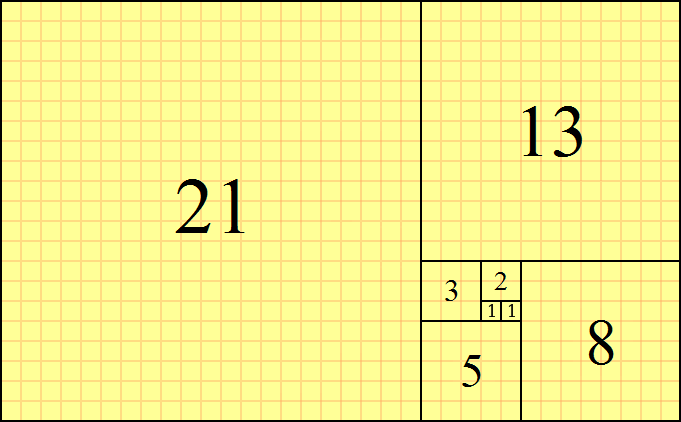
Golden Spiral
The golden spiral is what occurs when you spiral a line through the golden rectangle.
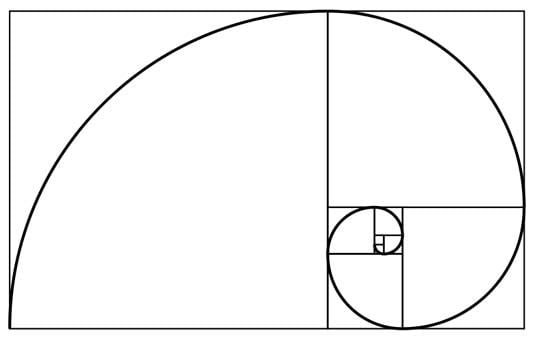
This spiral can be found throughout nature:

Applying the Golden Ratio in Art
Now we can get to some of the more interesting applications of the golden ratio.
The golden ratio has been used by artists to locate aesthetically pleasing areas to place our subjects and distribute weight in our paintings.
The Eyes Of The Golden Rectangle
One technique is to use the “eyes of the rectangle” to position your subjects. These “eyes” are indicated in blue below:

The Golden Section
Another option is to segment your painting into nine unequal sections using the golden ratio.
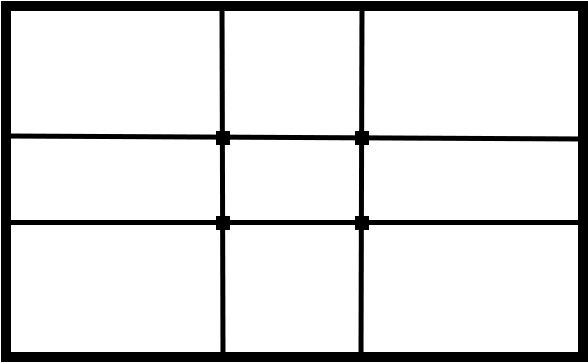
The ratio of the columns is 1: 0.618: 1. Likewise for the rows.
You can then use this diagram as a tool to ensure there is balance throughout your composition. I will show you some examples below.
This is a more complex version of the rule of thirds. The application of the golden section and the rule of thirds is basically the same.
Examples of the Golden Ratio
My Website
I could use the golden ratio to design this very website in an aesthetically pleasing manner. For example, I could distribute the content to sidebar widths according to the golden ratio.
I could also use the golden ratio to determine the size of my header in relation to my content, or my logo to my menu. There is no limit to how I could use the golden ratio.
This is not to say my website is designed strictly using the golden ratio – this is just for demonstration purposes.

The Golden Ratio In Paintings
In this painting by Georges Seurat, the golden ratio appears to have been used throughout the painting – to define the horizon, to place points of interest and to create balance in what would appear to be a very active scene.
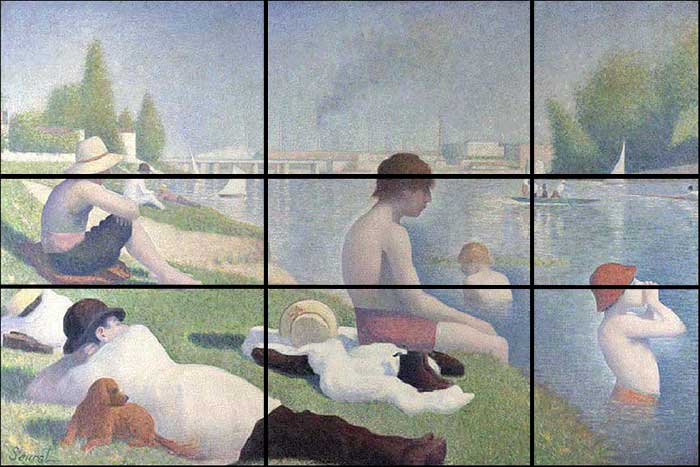
Georges Seurat also seems to have used the golden ratio in this painting. Notice the positioning of the jetty, the sail mast and the horizon.

This contemporary peice needs little explanation. It is just an arrangement of golden rectangles and colors.
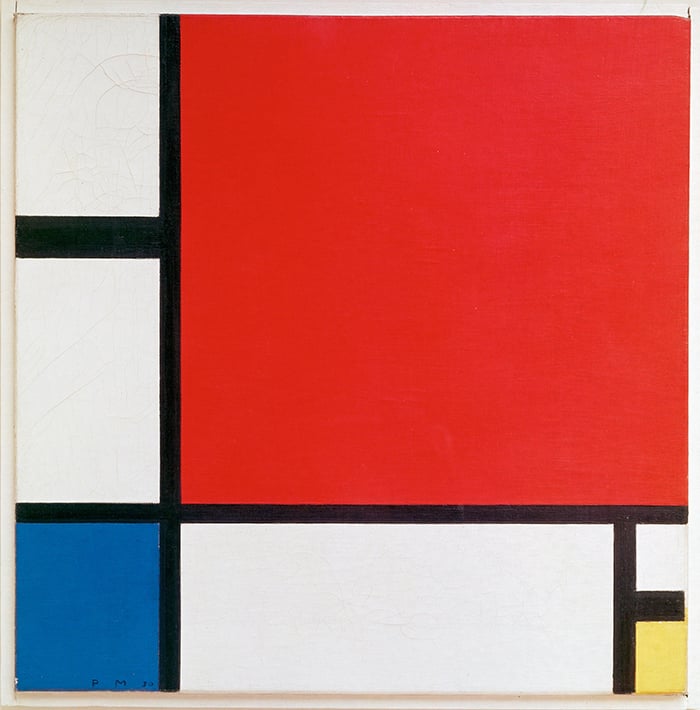
Take note of the position of the table and the edge of the ceiling in this painting by Salvador Dali, who seems to have used the golden ratio to help design a number of his paintings.

The golden ratio even appears to have been used in this classic painting by Michelangelo.

Summary
I hope this post helps you understand the importance of the golden ratio in art and design. But, as with many other art concepts, the golden ratio is just a tool to assist you. Do not end up being confined by always needing to follow the golden ratio.
The majority of famous paintings do not follow the golden ratio. But by using the golden ratio you may have a greater chance of your painting being aesthetically appealing.
If you want to learn more, refer to my detailed guide on composition.
Want to Learn More?
You might be interested in my Painting Academy course. I’ll walk you through the time-tested fundamentals of painting. It’s perfect for absolute beginner to intermediate painters.
Thanks for Reading!
I appreciate you taking the time to read this post and I hope you found it helpful. Feel free to share it with friends.
Happy painting!
Dan Scott

Draw Paint Academy




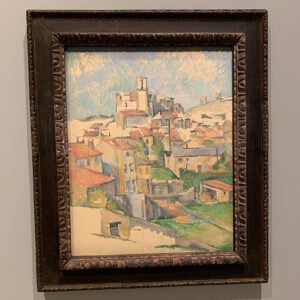
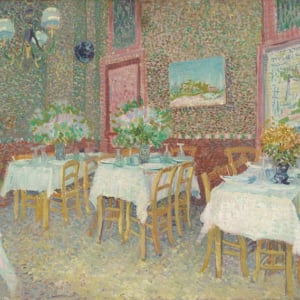

i read about the golden ratio before and have no idea how to use it and where to apply it.
i spend good time reading your explanation and where to use it make a lot of sense to me. thank you
very good and easy to understand and we have the option to use it or not.
thanks again
Thanks for the informative post!
Dan
Great post. I’ve read much about the Golden Ratio and it’s an absolute classic. I’m a beginner and I’d rather follow proven techniques than muddle through by myself. Many Thanks.
Hi Dan,
I enjoyed this article, very informative as usual. But golden ratio ?? Colour me dumb.
I just paint by the seat of my pants ( instinct).
I will continue following your articles, there is always something to learn, even for a fossil like yours truly.
Keep ’em coming Dan.
Thanks David! More to come. Dan
Thank you David! Your presentation of Golden Ratio as a scientific tool for artists was very exciting for me! I have been familiar with the golden ratio and its calculation, but its application by painters was absolutely new! I learned a lot!
I learned something new today. I knew about the rule of thirds but not about the golden ratio. Thank you.
I am a photographer and have used my gut to tell me what looks right. I am sure that I have a lot to learn.
I understand the rule, but am having a hard time visualizing it in a painting that I want to set up.
As so many others, I am a beginner. I knew about the Golden Ratio and what it was so I thought it would be a doddle when it was recently touched upon in an art class. Unfortunately, I very much struggled to train my eye to see both it and the Rule of Thirds or rather to apply it to my efforts.
I am so glad my search brought me to this page. This is the first time someone has explained it in an approachable, practical and clear way.
Many, many thanks
it’s aesthetically not aethetically.
Big deal!
For years, I used an old Disney short film, “Donald in Mathemagic Land” teaching my undergrad intro to Philosophy classes. The imagery is too dated now for students (e.g. rotary dial phones) but the range and variety of examples of the Golden Section is still captivating. It was always a great preview to hitting them with logic. Thank you for your post. It is a great explanation of a complex topic.
Just watched it again today! Yes!
Way cool! I just googled golden rectangle because I wanted to make a clay box. Read down about the golden spiral which I had seen previously but didn’t know the mathematics behind it. Great information with clear explanation. Thank you!
Seurat also seems to utilize a spiral within the composition of his figures in the Bathers painting but I don’t know whether it has the Golden ratio.
thanks, I finally understand the golden ratio.
Thank you. What a clear explanation of the Golden Mean. Not so scared of it now.
A great read & one of the more well explained articles I’ve read on the rule.
One of the things I always wonder though is: were these great works planned out as golden ratio pieces or did the artists just put together something aesthetically pleasing and it happens to ‘fit’ the formula.
For example, ive had students and collectors note that some of my work fits the golden ratio – to which i will nod and smile – even though I myself have never actually set out to design it this way. lol
Hi!
The Mondrian painting are not just squares, sort of speak.
Mondrian used a much deeper explanation for the use of color, each color has a separate meaning, for example. He was very serious in that. Maybe interesting for those who did not know this fact.
Thankyou this is such a fantastic explanation!
Thank you very much for this explanation, Dan. Very thorough but easy to understand.
Thanks so much! I now apply the information to my prints and paintings to see if I can accentuate or shift for balance and goldenness.